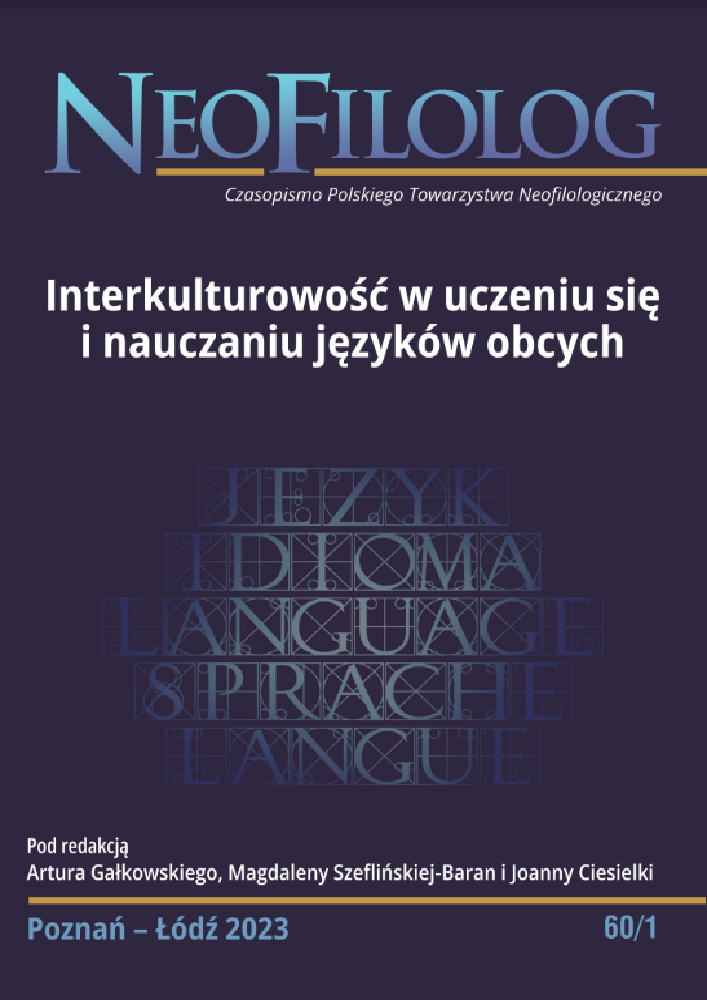Abstract
The learning of a foreign language cannot be carried out in the usual theoretical way, but it is necessary to broaden the scope, focusing on active praxis. In fact, it will be necessary to establish a basis that implies, on the one hand, the implementation of real elements of society and culture in the classroom and, on the other hand, that these elements are based on valid samples, which is what the CEFR-CV currently demands for the effective teaching of a language. Interculturality becomes an invaluable ally, given that in every situation in which it is possible to establish a direct relationship between the teaching of grammar from the perspective of active praxis and the linguistic realizations that result from this teaching action, we must observe that it is necessary to teach a language in which there are no predetermined models, having to attend to the habitual realizations used by native speakers in real interactions in all their variants and fields.
References
Bachman, L. (2000). Habilidad lingüística comunicativa, (en:) Llobera, M. (ed.), Competencia comunicativa. Documentos básicos en la enseñanza de lenguas extranjeras. Madrid: Edelsa, 105-128
Balches Arenas, R. S. (2009), Las distintas competencias en el inicio del aprendizaje de ELE. La interlengua como mediación didáctico-cultural. “Studia Romanica Bratislaviensia”, nº 8, t. II, 7-20.
Canale, M., Swain, M. (1980). Theoretical Bases of Communicative Approaches to Second Language Teaching and Testing. “Applied Linguistics”, 1, 1-47. DOI: https://doi.org/10.1093/applin/I.1.1
Celce-Murcia, M., Dornyei, Z., Thurrell, S.: 1995, Communicative competence: A pedagogically moti-vated framework with content specifications, “Apllied Linguistics”, 6: 5-35. DOI: https://doi.org/10.5070/L462005216
Consejo de Europa (2002), Marco común europeo de referencia para las lenguas: aprendizaje, enseñanza, evaluación. Madrid: Secretaría General Técnica del MECD-Subdirección General de Información y Publicaciones / Anaya.
Consejo de Europa (2021), Marco común europeo de referencia para las lenguas: aprendizaje, enseñanza, evaluación. Volumen complementario. Madrid: Secretaría General Técnica del MEFP/ Instituto Cervantes.
Dandrea, F. B. (2015), El abordaje de los aspectos socioculturales en la enseñanza del español como lengua segunda y extranjera. “Signos ELE”, 1-12.
Fernández Jódar, R. (2021), El estudio contrastivo-pragmático entre primeras y segundas lenguas de los registros formal y coloquial. “Studia Romanica Posnaniensia”, 48(2), 77-86. [última consulta 31.12.2022]. DOI: https://doi.org/10.14746/strop.2021.482.007
Galindo, M. (2005), La importancia de la competencia sociocultural en el aprendizaje de segundas lenguas. “Interlingüística”, nº 16, 431-441. En línea: https://acortar.link/3bP9sK [última consulta 31.12.2022].
Gómez del Estal Villarino, M. (2016), Los contenidos lingüísticos o gramaticales. La reflexión sobre la lengua en el aula de E/Le: criterios pedagógicos, lingüísticos y psicolingüísticos, (en:) Sánchez Lobato, J., Santos Gargallo, I. (eds), Vademécum para la formación de profesores. Madrid: SGEL, 159-179.
Guillén, C. (2005), Los contenidos culturales, (en:) Sánchez Lobato, J. y Santos Gargallo, I. (eds.), Vademécum para la formación de profesores. Madrid: SGEL, 835-851.
Jensen, A. A. (1995), Defining Intercultural Competence. A Discussion of its Essential Components and Prerequisites, (en:) L. Sercu (ed.). Intercultural Competence. A New Challenge for Language Teachers and Trainers in Europe. Volume I: The Secondary School, Aalborg: Aalborg University Press, 41-52.
Méndez, M. C. (2015), La interculturalidad como elemento clave en el aprendizaje de lenguas, (en:) Actas del I congreso de español como lengua extranjera del Magreb (I CELEM), 20-26. En línea: https://acortar.link/iwBKZ3 [última consulta 20.09.2022].
Miquel, L., Sans, N. (2004), El componente cultural: un ingrediente más en las clases de lengua, “redELE”, nº 0, 1-13. En línea: https://acortar.link/4ZkMuA [última consulta 31.12.2022].
Santamaría, R. (2010), La competencia sociocultural en el aula de español L2/LE: una propuesta didáctica. Madrid: Secretaría General Técnica – Subdirección general de Documentación y Publicaciones del ME/ASELE.
License
Copyright (c) 2023 Cecylia Tatoj, R. Sergio Balches Arenas

This work is licensed under a Creative Commons Attribution-NoDerivatives 4.0 International License.
Authors
Authors of texts accepted for publication in Neofilolog are required to complete, sign and return to the Editorial team’s office the Agreement for granting a royalty-free license to works with a commitment to grant a CC sub-license.
Under the agreement, the authors of the texts published in Neofilolog grant Adam Mickiewicz University in Poznań a non-exclusive, royalty-free license and authorize the use of Attribution-NoDerivatives 4.0 International (CC BY-ND 4.0) Creative Commons sub-license.
The authors retain the right to the free disposal of the work.
Users
Interested Internet users are entitled to use works that have been published in Neofilolog since 2017, under the following conditions:
▪ attribution – obligation to provide, together with the distributed work, information about the authorship, title, source (link to the original work, DOI) and the license itself.
▪ no derivatives – the work must be preserved in its original form. Without the author's consent, it is not possible to distribute the modified work in the form of translations, publications, etc.
Copyrights are reserved for all texts published since 2017.
Miscellaneous
Adam Mickiewicz University in Poznań retains the property right as a whole (layout, graphic form, title, cover design, logo etc.).

